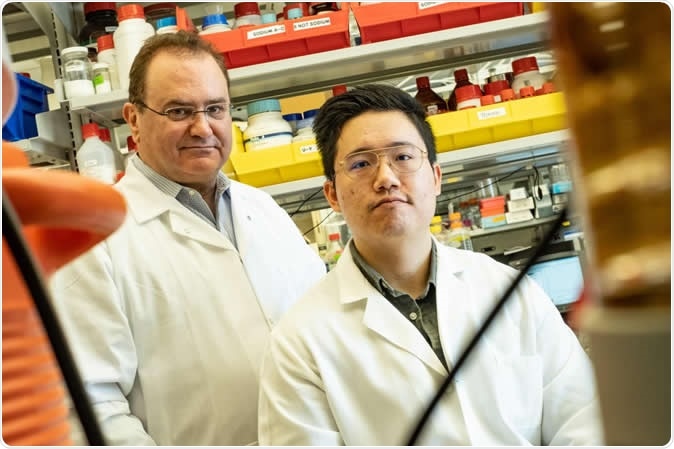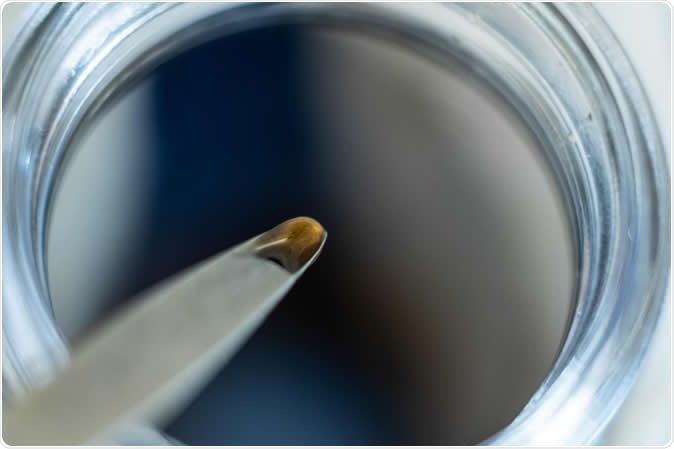Rather like fishermen using bait to catch their fish, bioengineers at Rice University baited a hydrogel scaffold with biomolecules capable of promoting healing in injured tissues like bone, cartilage or skin.
Polymeric hydrogels have been used for many years to provide mechanical scaffolds over which body cells can grow to accelerate tissue healing in injured tissues like bone or cartilage,. However, they are essentially inert, and cannot promote healing by themselves.

Rice University bioengineer Antonios Mikos, left, and graduate student Jason Guo led a team that developed modular, injectable hydrogels enhanced by bioactive molecules anchored in the chemical crosslinkers that give the gels structure. Image Credit: Jeff Fitlow / Rice University
The crosslinker
In the current research, growth factors and other bioactive molecules become part of the hydrogel. This is by making use of a chemical called poly(glycolic acid)–poly(ethylene glycol)–poly(glycolic acid)-di(but-2-yne-1,4-dithiol) (PdBT), as the crosslinker in the hydrogel. Crosslinkers in a hydrogel are the key to maintaining its structural integrity even when it has absorbed many times its weight of water.
PdBT is a compound that can be used to crosslink polymers, and is biodegradable. It can bind to tissue-specific biomolecules (both small peptides and large molecules such as extracellular matrix components, specific to various tissues, at room temperature to become biofunctionalized. PdBT rapidly crosslinks the hydrogel polymer to create a highly swollen bioactive, biocompatible and biodegradable hydrogel. The speed of hydrogel formation allows it to fill tissue defects quickly, and keep other reactive groups on the PdBT away from the tissue cells.
The active hydrogel created in this way readily encapsulates mesenchymal stem cells from the host. The conjugated biomolecules remain anchored to the hydrogel directly, presenting them directly to the tissue. This also prevents their diffusion outside the wounded area. This could cause unwanted consequences such as inactivation or redundant tissue growth.
The researchers used data from experiments on bone and cartilage which confirmed that crosslinkers like PdBT could bind biomolecules and form a hydrogel when they are mixed with water containing a catalyst.

Hydrogels developed at Rice University incorporate crosslinkers that can incorporate bioactive molecules and help heal a variety of wounds. Image Credit: Jeff Fitlow / Rice University
The functionalized hydrogel
The hydrogel mixture can be injected into wounded tissue. There it swells by absorbing water to fill the tissue defect, and the biomolecules come into contact with stem cells in the host tissue. This pulls them into the wound to act as seed centers from which new growth is initiated. As new tissue grows inside the wound, the hydrogel degrades and finally disappears.
The current research built on earlier experience with hydrogels to integrate the biomolecules into the hydrogel itself for ease of application. The advantage is that no secondary injection system is required to give the biomolecules access to the tissue.
Jason Guo, another research leader, said: “Our big advantage is that we directly incorporate those biomolecules for the specific tissue right into the crosslinker itself. Then once we inject the hydrogel, the biomolecules are right where they need to be.”
They were also able to create customized mixes that only require the bioactive molecules to be added to the hydrogel at room temperature for immediate use. The preparation process is easy, and prevents the thermal degradation of the biomolecules which is harmful to their intended activity.
Antonios Mikos, leader of the research team, said, “This is important not only for the ease of preparation and synthesis, but also because these molecules may lose their biological activity when they're heated. This is the biggest problem with the development of biomaterials that rely on high temperatures or the use of organic solvents.”
The catalyst
Biomolecule conjugation with the crosslinker was made possible by a type of chemical reaction called alkyne-azide click chemistry. However, the catalysts used in click chemistry are not usually compatible with water. The team succeeded in bypassing this obstacle with the use of a particular catalyst, based on ruthenium, which is both non-toxic to tissue and soluble in water, besides being compatible with the hydrogel’s polymer matrix. This was the first time this molecule had been applied to biomolecular frameworks.
Guo explains: “Others (catalysts) are often cytotoxic, or they're inactive under aqueous conditions, or they might not work with the specific kind of alkyne on the polymer. This particular catalyst works under all those conditions - namely, conditions that are very mild, aqueous and favorable to biomolecules."
More work will be needed to evaluate the activity of biomolecules immobilized in a hydrogel, and what happens if they diffuse into the surrounding area as the PdBT breaks down. Regardless, this study provides a promising approach to tissue repair using biofunctionalized hydrogels.
Source:
Guo J. L. et al., (2019). Modular, tissue-specific, and biodegradable hydrogel cross-linkers for tissue engineering. Science Advances. DOI: 10.1126/sciadv.aaw7396 - https://advances.sciencemag.org/content/5/6/eaaw7396